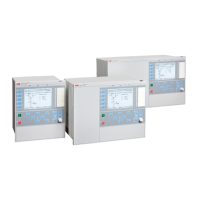sn
R
al alreq CT L
2
pn n
k ma x
I I
S
E E R R
I I
³ = × + +
æ ö
×
ç ÷
è ø
EQUATION1675 V1 EN (Equation 4)
sn
R
al alreq CT L
2
pn n
kzone1
I I
S
E E R R
I I
³ = × + +
æ ö
×
ç ÷
è ø
EQUATION1676 V1 EN (Equation 5)
where:
I
kmax
Maximum primary fundamental frequency current for close-in forward and
reverse faults (A)
I
kzone1
Maximum primary fundamental frequency current for faults at the end of zone 1
reach (A)
I
pn
The rated primary CT current (A)
I
sn
The rated secondary CT current (A)
I
n
The nominal current of the protection IED (A)
R
CT
The secondary resistance of the CT (W)
R
L
The resistance of the secondary wire and additional load (W). In solidly
grounded systems the loop resistance containing the phase and neutral wires
should be used for phase-to-ground faults and the resistance of the phase wire
should be used for three-phase faults.
In isolated or high impedance grounded systems the resistance of the single
secondary wire always can be used.
S
R
The burden of an IED current input channel (VA). S
R
=0.020 VA/channel for I
r
=1
A and S
r
=0.150 VA/channel for I
r
=5 A
a This factor is a function of the primary time constant for the dc component in the
fault current.
a= 2 for the primary time constant T
p
£ 50 ms
a = 3 for the primary time constant T
p
> 50 ms
k A factor of the primary time constant for the dc component in the fault current for
a three-phase fault at the set reach of zone 1.
k = 4 for the primary time constant T
p
£ 30 ms
k = 6 for the primary time constant T
p
> 30 ms
2.1.6.3 Restricted ground fault protection (low impedance differential)
The requirements are specified separately for solidly grounded and impedance
grounded transformers. For impedance grounded transformers the requirements for the
phase CTs are depending whether it is three individual CTs connected in parallel or it
is a cable CT enclosing all three phases.
Section 2 1MRK504116-UUS C
Requirements
24
Application manual

